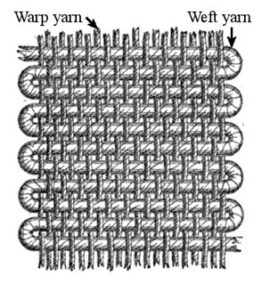The word – Textile is a very broad term, originally it applied only to woven fabrics, but now, fibers, yarns, fabrics either organic/natural or man-made. Textile word derived from the Latin “textilis” and the French “texer” – meaning “to weave”, originally it was only woven fabrics, but now it includes knitting, bonding, felting, non-woven, tufting.
Textile processing stages: Raw Materials > > Fibers > > Yarns (Spinning) > > Fabrics (Weaving/Knitting) > Grey Fabrics > Finished Fabrics (Wet Processing/Dyeing/Printing) > > Garments or Home Textiles (Sewing). Earlier, textiles were mainly of two types – natural and man-made, wherein, cotton, jute, wool, mohair, silk, khadi etc. are natural textiles, and, polyester, synthetic, nylon etc. are man-made textiles, however, recently we see a rise of technical textiles, that includes, nonwoven, geo textiles, agri-textiles, automotive textiles, packaging textiles and more. In recent days, non-woven and technical textiles are being hugely used, I shall write a separate article about it later. The textile industry world over has been witnessing massive innovations and changes, new trends are being seen in all the stages of textiles manufacturing. Innovations are in the agriculture or raw materials, innovations are in fibers, innovations are in yarns, innovations are in fabrics, innovations are in processing, innovations are in machines, innovations are in dyes & chemicals, innovations are in garmenting and innovations are in all other stages. In earlier days handloom were used for fabric manufacturing, but with the innovations in machines, nowadays, power looms. Airjet looms, waterjet looms etc. produces a huge quantity and different types of fabrics.
Basic fabric structure:
Yarns in horizontal is called weft and yarns in vertical is called warp.
Every country and tradition carries a different textile pattern, the traditional and ancient textiles were different country-to-country, but these days, with the latest machines, technologies, e-trade and modern textiles, all the countries can produce any textiles, however, there are still few clusters which are famous amongst these countries only, such as India and other Asian countries are famous for natural textiles, SE Asia countries are famous for synthetic or polyester, EU is famous for technical textiles and textile machineries, Africa is famous for cotton and man-made products and middle-east is famous for their textiles.
Textile is a commodity world over, the prices are being fluctuated every day in every country, and sometimes, the prices are different within a same country, for an example, price of cotton yarns are different in South India and North India in the same day. Likewise, the price of cotton yarns is different in Brazil and Bangladesh in the same day. There are many tools available to track the updates digitally and many are still tracking the updates manually.
The benefits of textiles industry are huge, millions of people are working in textiles industry globally either directly or in-directly, the market size of textiles industry was valued around US$1000 billion in 2022 and projected to reach around US$1500 by 2030. Textiles are the world’s 7th most trade products. Countries which are largest textiles manufacturers such as Bangladesh, Cambodia, Indonesia, China, India, Philippines, Sri Lanka, Pakistan, Egypt, Turkey, Brazil, Germany, France, Italy, Taiwan, Vietnam etc. has many employments into this industry and new jobs are being available for the skilled and un-skilled workers, China is perhaps world’s top exporter for textiles.
The allied industries are also greatly benefited due to the expansion in textiles/garments/fashion industry globally. Allied industries such as trade fair & expo, packaging, freight forwarding and transport, warehousing, IT and software, consultancy and management, finance, modelling, cosmetics and jewellery etc. are also booming along with the expansion or textiles/apparel/fashion industry globally.
This is a first article from the series about Textiles articles, more articles to come, you can check back regularly.




